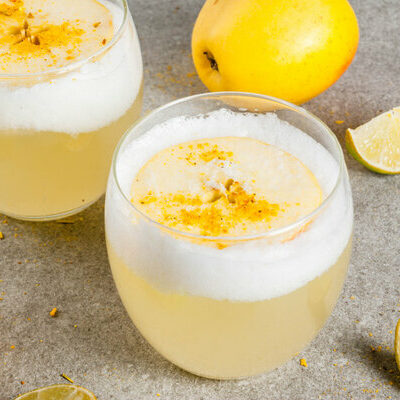
Pisco Sour
What is a Pisco Sour?
Pisco Sour is a cocktail of Peruvian or Chilean origin. It is a popular drink in both countries. The cocktail uses Pisco, a type of South American brandy, as the base liquor and also contains lime juice, syrup, egg whites, and Angostura bitters. The Chilean version uses Pisco, sugar, lemon or lime juice, and egg whites. This cocktail has a frothy white appearance and a fruity and sweet taste.
- It is the national drink of Chile and Peru.
- International Pisco Sour Day is celebrated on the first Saturday of every February and, in Peru, it is a public holiday.
Some of the most popular cocktails from South America include:
- Singani Chuflay (Bolivia)
- Pisco Sour (Chile / Peru)
- Fernet and Coke (Argentina)
- Quentão (Brazil)
- Terremoto (Chile)
- Batida (Brazil)
- Canelazo (Colombia / Ecuador)
- Caipirinha (Brazil)
- Cusqueña (Peru)
- Quilmes (Argentina)
- Pilsener (Ecuador)
Origin of Pisco Sour
This cocktail originated in Peru, though Chile also lays claim to it. The Peruvian history, which is the one accepted by most, credits its creation to Victor Vaughen Morris, an American who ran the Morris Bar in Lima. He created the cocktail with Pisco as an alternative to the whiskey sour. Later, the cocktail was further developed by bartender Mario Bruige, who added the egg white and Angostura bitters.
Nutrition
Nutritional profile for Pisco Sour (1 cocktail/159 g):

*Percent Daily Values are based on a 2000 calorie diet.
Pisco contains antioxidants, plus it is good for gut health and helps deal with digestive issues. Lemon juice has very few calories but is chock full of nutrition, as a single lemon can provide 30 mg of vitamin C. In addition, lemon juice contains plenty of different flavonoids and phenolic compounds, which are powerful antioxidants. Regular consumption of lemon juice can also help in lowering the risk of stroke, cancer, and asthma, while increasing iron absorption, immune system functioning, and weight loss. Furthermore, the egg whites provide protein as well as vitamin A, iron, vitamin B12, riboflavin, choline, zinc, and calcium in decent quantities.
Commercial production
To prepare a Pisco Sour, the ingredients required are Pisco, simple syrup, lemon juice, egg white, and Angostura bitters. First, all the ingredients except the Angostura bitters are poured into a cocktail shaker and shaken well. Then, they are strained into a glass. Finally, the bitters are poured in at the top. This cocktail is usually served in a Delmonico glass or an Old Fashioned glass.
Pisco sour recipes
This has many incarnations. The traditional versions from Peru and Chile differ, and there are numerous other twists that bartenders make to create a fresh drink. Here are a few recipes to try:
- Pisco Sour
- The Cupid’s Cup
- Plum Pisco Sour
- Tropical Passion Fruit Pisco Sour
- Rhubarb and Honey Sour
- Lavender Pisco Sour
- Habanero Hibiscus Sour
- Lemon Pisco Sour Cake
- Coconut Tart
- Cupcake
- Green Juice
FDA regulations
The TTB defines Pisco as Peruvian grape brandy stored in anything other than oak containers. Pisco sour is defined as a cocktail containing pisco and lemon juice or oil or natural lemon flavor. In the EU, both Chilean and Peruvian piscos have been granted geographical indication tags.
The FDA defines lemon juice as the unfermented juice obtained from ripe lemons from which seeds and excess pulp are removed. The acidity of concentrated lemon juice must not exceed 15 percent of the acidity of the finished food. Also, sugar or sucrose is defined as the product obtained by crystallization from sugar cane or sugar beet juice that has been extracted by pressing or diffusion, then clarified and evaporated. However, eggs have no standard of identity provided by the FDA.
References
Simon Difford, Sour Cocktails: Pisco Sour, Difford’s Guide for Discerning Drinkers, https://www.diffordsguide.com/g/1133/sour-cocktails/pisco-sour
National Institute of Alcohol Abuse and Alcoholism, Alcohol’s Effects on the Body, https://www.niaaa.nih.gov/alcohols-effects-health/alcohols-effects-body
